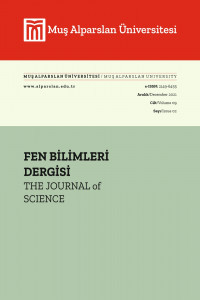HAFİF 103,105,107 Te İZOTOPLARININ KABUK MODELİ HESAPLAMALARI SHELL MODEL CALCULATIONS OF LİGHT 103,105,107Te ISOTOPES
Bu çalışmada, N= Z= 50 çift kapalı kabuğu etrafında bulunan iki proton artı artan nötron sayılarına uyan 103,105,107Te izotopları için standart nükleer kabuk modeli hesaplamaları yapılmıştır. Yapılan kabuk modeli hesaplamalarında 100Sn çekirdeği kor olarak kabul edilmiş ve bu kor üzerinde bulunan 2s1/2, 1d3/2, 1d5/2, 0g9/2 ve 0h11/2 tek parçacık yörüngeleri model uzayı olarak seçilmiştir. İki- cisim etkin etkileşmeleri olarak CD-Bonn nükleon- nükleon (NN) etkin etkileşmeleri kullanılmış ve çok-kabuklu kabuk modeli hesaplamaları Drexel Üniversitesi Kabuk Modeli (DUSM) kodu kullanılarak yapılmıştır. Hesaplamalar neticesinde 103,105,107Te izotoplarının taban ve düşük uyarılma durumları, pariteleri ve bu durumlara karşılık gelen uyarılma enerjileri elde edilmiştir. Elde edilen teorik enerji spektrumları mevcut kaynaklarda yer alan deneysel değerlerle karşılaştırılmış ve kabul edilebilir bir uyum içerisinde olduğu bulunmuştur.
Anahtar Kelimeler:
Kabuk Modeli, 103, 105, 107Te, Enerji Spektrumu, CD- Bonn, NN Etkileşmeleri
HAFİF 103,105,107 Te İZOTOPLARININ KABUK MODELİ HESAPLAMALARI SHELL MODEL CALCULATIONS OF LİGHT 103,105,107Te ISOTOPES
In this study, the standard shell model calculations for the 103,105,107Te isotopes which are the nuclei consisting of two protons plus increasing neutron number around the doubly magic N= Z= 50 core. It is choosen 100Sn as a doubly -magic core and the single particle orbits 2s, 1d, 1d, 0g ve 0hmodel space. It has been carried out the shell model calculations by using the Drexel University Shell Model (DUSM) code and CD-Bonn two-body effective interactions. As a result of the calculations, the low-lying states, parities, and corresponding energies are calculated for the 103,105,107Te isotopes. The obtained theoretical energy spectra are compared with available experimental data and found to be reasonable agreement with the experimental data
Keywords:
Shell Model, 103, 105, 107Te, Energy Spectra, CD- Bonn, NN interactions,
___
- Mayer, M. G., On Closed Shells in Nuclei II., Physical Review, 75, 1969, 1949.
- Talmi, I., Simple Models of Complex Nuclei. Harwood Academic Publishers, 1074p., New York, 1993.
- Liddick, S. N., Grzywacz, R.,Mazzocchi, C.,Page, R.D., Rykaczewski, K.P., Batchelder, J.C.,Bingham, C.R., Darby, I.G., Drafta, G., Goodin, C., Gross, C.J., Hamilton, J.H.,Heeht, A.A., Hwang, J.K., Hyushkin, S., Joss, D.T.,Korgul, A., Królas, W.,Lagergren, K., Li, K., Tantawy, M.N., Thomson, J. and Winger, J.A., Discovery of 109Xe and 105Te: Superallowed
- α Decay near Double Magic 100Sn, Phys. Rev. Letters PRL 97, 082501,4p, 2006.
- Dikmen, E., Shell Model Description of Neutron-Deficient Sn Isotopes, Communications
- in Theoretical Physics, 515, 899-903, 2009.
- Fahlander, C., Palacz, M., Rudolph, D., Sohler, D., Blomqvist, J., Kownacki, J., Lagergren, K., Norlin, L.O., Nyberg J., Algora, A., Andreoiu, C., Angelis de G., Ataç, A., Bazzacco, D., Berglund, L., Bӓck, T., Cederkӓll, J., Cederwall, B., Dombradi, Zs., Fant, B., Farnea, E., Gadea, A., Górska, M., Grawe, H., Hashimoto- Saitoh, N., Johnson, A., Kerek, A., Klamra, W., Lenzi, S.M., Likar, A., Lipoglavšek, M., Moszyński, Napoli, D.R., Rossi-Alvarez, C., Roth, H.A., Saitoh, T., Seweryniak, D., Skeppstedt, Ö., Weiszflog M. and Wolińska, M., Excited states in 103Sn: Neutron single- particle energies with respect to 100Sn, Physical Review C 63,021307(R),2001.
- Dikmen E. Öztürk, O., and Vallieres, M., Shell model structure of mid-heavy even-even Sn isotopes , J. Phys. G: Nuclear Particle Physics 36 045102 ,12pp , 2009.
- Ekström A. Cederkall, J., Fahlander, C., Hjorth-Jensen, M., Ames, F., Butler, P.A., Davinson, T., Eberth, J., Fincke, F., Görgen, A., Gorska, M., Habs, D., Hurst, A.M., Huyse, M., Ivanov, O., Iwanicki, J., Kester, O., Köster, U., Marsh, B.A., Mierzejewski, J., Reiter, P., Scheit, H.,
- Schwalm, D., Siem, S., Sletten, G., Stefanescu, I., Tveten, G.M., Van de Walle, J., Van Duppen, P., Voulot, D., Warr, N., Weisshaar, D., Wenander, F., and Zielinska, M., 0gs+→ 21
- + Transition Strengths in 106Sn and 108Sn, Physical Review Letters,
- 101, 012502, 4p, 2008.
- Handinia B. Cederwall, B., Lagergren, K., Blomqvist, J., Bӓck, T., Eeckhaudt, S., Grahn, T., Greenlees, P., Johnson, A., Joss, D.T., Julin, R., Juutinen, S., Kettunen, H., Leino, M., Leppӓnen, A.-P., Liotta, R.J., Nieminen, P., Nyman, M., Pakarinen, J., Paul, E.S., Rahkila, P., Scholey, C., Uusitalo, J., Wadsworth, R., and Wiseman, D.R., First indentification of γ-ray
- transitions in 107Te, Physical Review C 70, 064314, 4p, 2004.
- Vallieres M., Novoselsky A., Drexel University Shell Model (DUSM) algorithm. Nuclear Physics A 570, 345c, 1993.
- Dikmen E., Shell Model Studies in the sdgh shell for the proton drip line Z=51 isotopes Drexel University, Ph.D. Thesis, 115p, USA, 2002.
- Novoselskv A., Katriel, J., Gilmore, R., Coefficients of fractional parentage in the L-S coupling scheme, Journal of Mathematical Physics, 29, 6, 1988.
- C.Lanczos, An Iteration Method fort he Solution of the Eigenvalue Problem of Linear Differential and Integral Operators, Journal of Research of. National Bureau of Standards, 45, 4, 1950.
- Hjorth-Jensen, M., Kuo, T.T.S., and Osnes, E., Realistic effective interactions for
- nuclear systems. Physics Reports, 261, 3-4, 125-270, 1995.
- ISSN: 2147-7930
- Yayın Aralığı: Yılda 2 Sayı
- Başlangıç: 2013
- Yayıncı: Muş Alparslan Üniversitesi
Sayıdaki Diğer Makaleler
IŞIK ÜNİTESİNİN ÖĞRETİMİNDE BİLGİSAYAR ANİMASYONLARININ ETKİSİ
Yasemin KOÇ, Ümit ŞİMŞEK, Cemil HAS
SİVRİCE (ELAZIĞ) FAY ZONUNDA RADON GAZI
176,178,180Hf İZOTOPLARINDA FOTON SAÇILMA TESİR KESİTLERİNİN HESAPLANMASI
Hüseynqulu QULİYEV, Ekber GULIYEV
STAFİLOKOKSİK HAŞLANMIŞ DERİ SENDROMU
Emine GÖKÇEOĞLU, Hanifi KÖRKOCA
YATAN HASTA KATLARINDAKİ KAT SEKRETERLERİNİN İŞ YÜKÜ ANALİZİ
KATI FAZ FERMENTASYONU (KSF) TEKNİĞİ ile Bacillus subtilis ATCC 6051’den
Sedat KAYA, Yusuf ÖNEN, Fikret UYAR, Nurullah AKCAN
